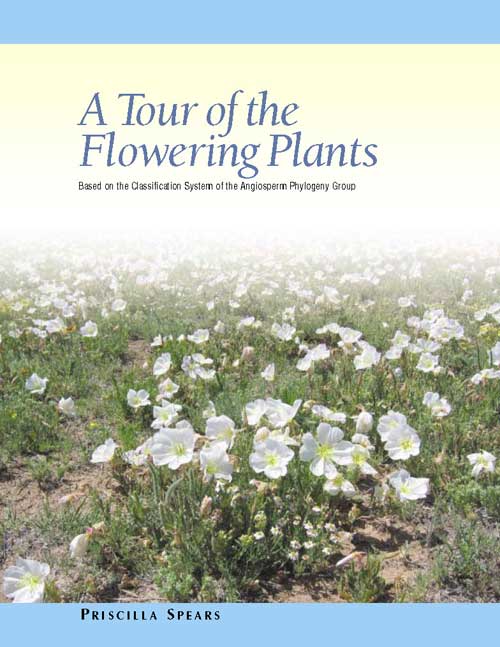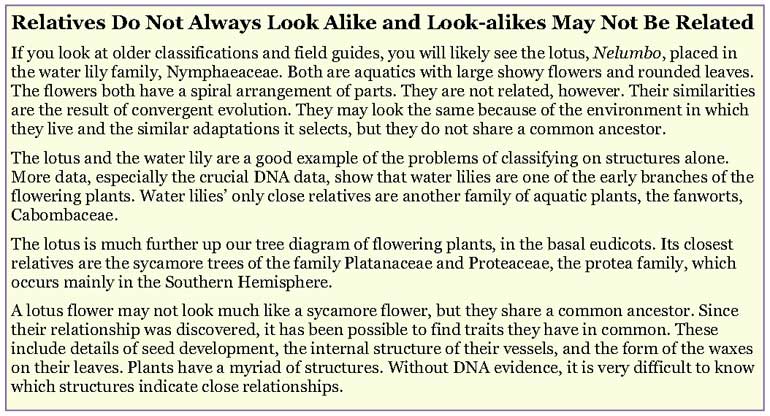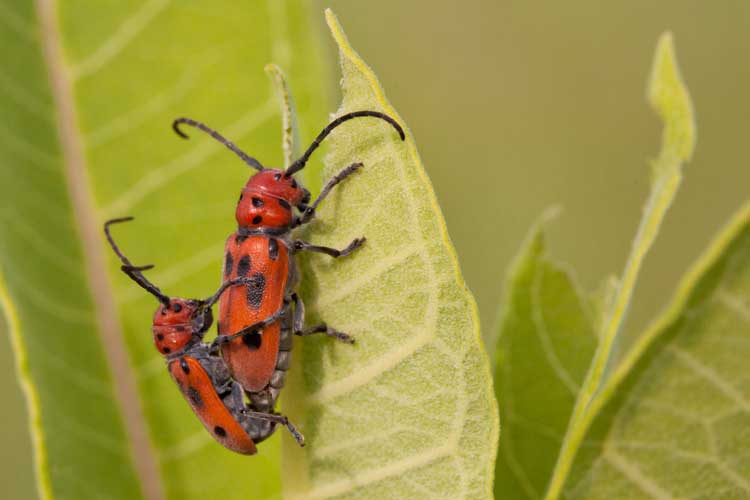

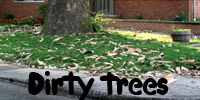
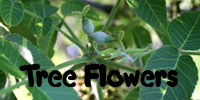
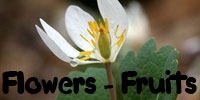
(Additional content at flickr Photostream and YouTube Channel)
If you have botany questions or comments please email BobK . Thanks!
July 20, 2010
Catawba Island, Portage County, Ohio.
Today we drove to the
tip of Catawba island and waved bye-bye to the kid, who
caught Miller's Ferry to South
Bass Island from which she hopped over to OSU's F.T. Stone Laboratory
on wee little Gibraltar Island for five weeks of study during
which she changed from someone who knew way less about entomology than
me into someone who knows way more about entomology than me.
Because
that happened by her learning a lot about bugs instead of me
forgetting a lot about them (although I think that may have happened also), it's
great! Stone Lab is great! Go there and learn about bugs!
On the way back, her happy mom and I drove over the narrow inlet that almost makes Catawba Island an island, an inlet that is home to a huge and striking population of a huge and striking plant, Nelumbo lutea (Nelumbonaceae, the lotus family). Nelumbo, while it is a huge plant, is not a huge genus. There are just two species, constituting one of the many intriguing eastern Asian - eastern North American pairs of closely related but widely disjunct taxa. This peculiar distribution pattern is generally attributed to the fragmentation of a once-contiguous mixed mesophytic forest, the so-called "arcto-tertiary geoflora." This biome spread across the northern hemisphere during a warm period from 65 to 15 million years ago, when the continents were joined by the Bering land bridge. The Asian lotus species, Nelumbo nucifera, is an important spiritual symbol in many eastern religions, hence one prevalent common name for it is "sacred lotus." Because we have a different cultural tradition, based upon the separation of church and stamen, perhaps our species should be called "secular lotus." Perhaps, but it's usually just called "American lotus."

Secular (American) lotus at Catwaba Island inlet, Portage County, Ohio. July 20, 2010.
On the way back, her happy mom and I drove over the narrow inlet that almost makes Catawba Island an island, an inlet that is home to a huge and striking population of a huge and striking plant, Nelumbo lutea (Nelumbonaceae, the lotus family). Nelumbo, while it is a huge plant, is not a huge genus. There are just two species, constituting one of the many intriguing eastern Asian - eastern North American pairs of closely related but widely disjunct taxa. This peculiar distribution pattern is generally attributed to the fragmentation of a once-contiguous mixed mesophytic forest, the so-called "arcto-tertiary geoflora." This biome spread across the northern hemisphere during a warm period from 65 to 15 million years ago, when the continents were joined by the Bering land bridge. The Asian lotus species, Nelumbo nucifera, is an important spiritual symbol in many eastern religions, hence one prevalent common name for it is "sacred lotus." Because we have a different cultural tradition, based upon the separation of church and stamen, perhaps our species should be called "secular lotus." Perhaps, but it's usually just called "American lotus."

Secular (American) lotus at Catwaba Island inlet, Portage County, Ohio. July 20, 2010.
The lotus family, Nelumbonaceae, consists only of the genus Nelumbo. These are perennial
herbs with stout fleshy rhizomes, bearing disk-shaped leaves held above
the water by a petiole (leafstalk) that is attached in the center of
the leaf, an attachment type that is called "peltate."
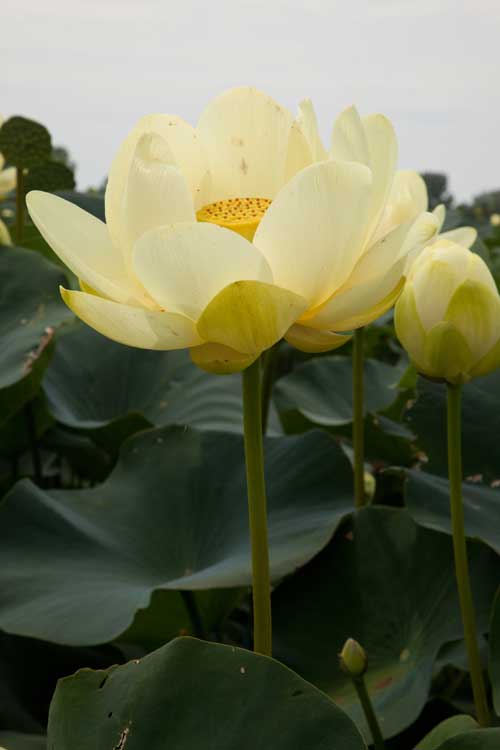
Secular (American) lotus. Note peltate leaves held above the water.

Secular (American) lotus. Note peltate leaves held above the water.
The flowers are bisexual (hermaphroditic, i.e., containing both stamens and carpels), radially symmetric, large and showy.
They are held stiffly upwards, just overtopping the leaves. The
perianth consists of 2-5 outermost sepals, grading into 20-30 spirally
arranged petals that are yellow in our species, pink to red in the Asian N. nucifera.
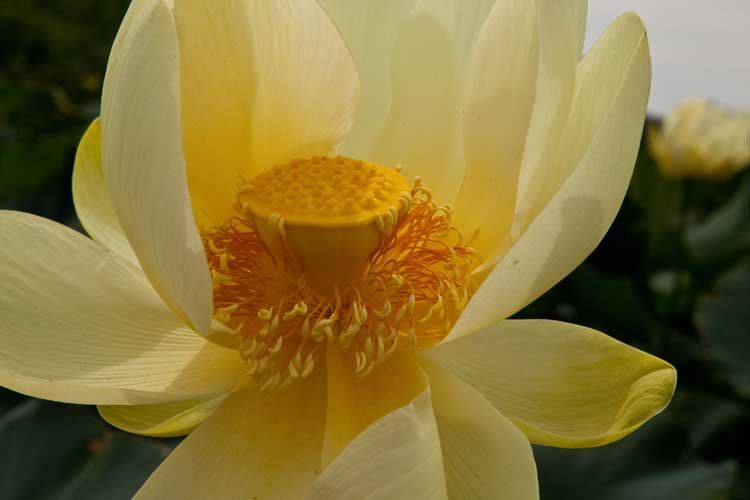
Secular (American) lotus. Note numerous, spirally arranged petals and stamens.

Secular (American) lotus. Note numerous, spirally arranged petals and stamens.
Each
flower bears numerous widely separated ovaries loosely embedded in
pockets just beneath the flat top of an unique enlarged inverted
cone-shaped receptacle that
eventually develops into Large Lotus Pods that are perfect for adding
texture and a touch of rustic charm to your floral arrangements.
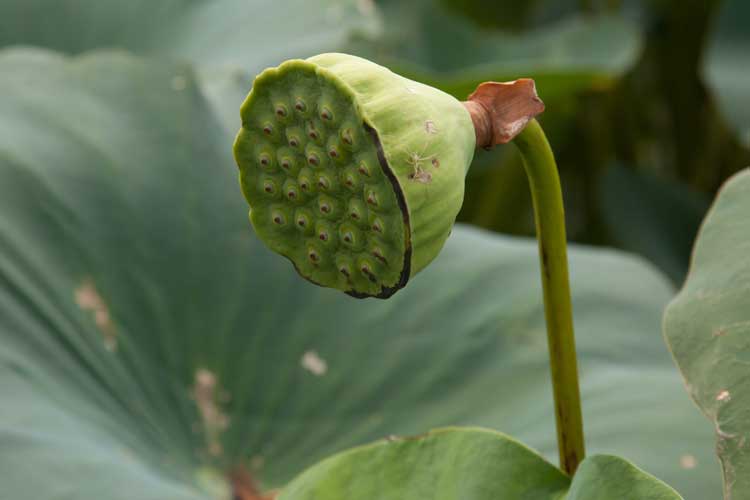
Nelumbo receptacle shortly after petal-fall, but before the development of rustic charm.
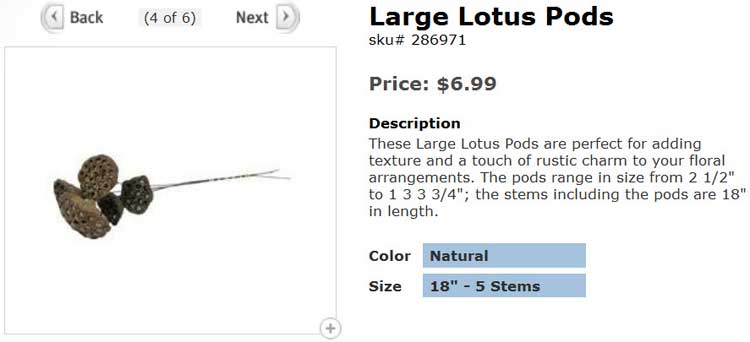

Nelumbo receptacle shortly after petal-fall, but before the development of rustic charm.
There are no styles; the
stigma just sits atop the ovary, making the following zoomed-in piece
of the picture above look really creepy, like a slew of alien pop-eyes
all looking sort of, but not quite, at the same thing.
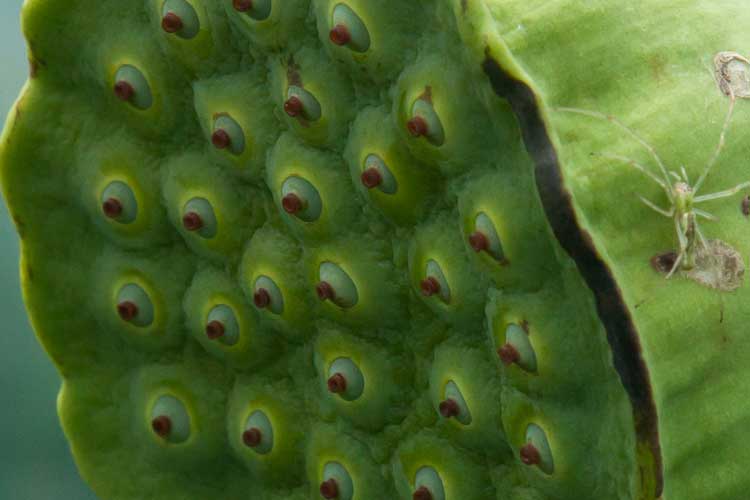
Spooky zoomed-in view of Nelumbo receptacle, showing ovaries with sessile stigmas.
Numerous single-seeded fruits sunken into pits atop an enlarged receptacle constitute a peculiar type of "false fruit" that is sometimes called an "accessory fruit." The only other vaguely similar accessory fruits are the wholly unrelated strawberry-type ones in the rosaceous genera Fragaria and Duchesnia. And yes, these lotus infructescences are those charming things you sometimes see in hobby shopes, for use in flower arrangements.

Spooky zoomed-in view of Nelumbo receptacle, showing ovaries with sessile stigmas.
Numerous single-seeded fruits sunken into pits atop an enlarged receptacle constitute a peculiar type of "false fruit" that is sometimes called an "accessory fruit." The only other vaguely similar accessory fruits are the wholly unrelated strawberry-type ones in the rosaceous genera Fragaria and Duchesnia. And yes, these lotus infructescences are those charming things you sometimes see in hobby shopes, for use in flower arrangements.

Arghh. Crass commercialism --the downside of "secular"?
The taxonomic position of Nelumbo has recently been revised. Traditionally, owing to a strong resemblance to the "water-lilies" Nymphaea and Nuphar which are also
robust aquatic herbs with circular leaves and showy flowers composed of
many separate parts spirally arranged, they were placed along with the
water-lilies either in the same family (Nymphaeaceae) or alongside them
in a separate family, both within the Order Nymphaeales.
During the past few decades there's been a revolution, still ongoing, in plant classification fostered both by a greater acceptance of cladistic systems that are very strict about basing classification on phylogeny, and the wealth of data from DNA sequences. One very good guide to the new view of flowering plant systemetics is a great book called "A Tour of the Flowering Plants" by Priscilla Spears, published in 2006 by the Missouri Botanical Garden Press.
The book is based on the classification system of the Angiosperm Phylogeny Group. It includes a simplified tree that Spears calls a "map to help you find your way around the thowering plants." The "map," and accompanying text, explains that there is a small group comprising only about 3% of the flowering plants that diverged early from the flowering plant lineage, appropriately termed "basal angiosperms." Close to the ancestral seed plants, this group includes the water lilies (Nymphaeales), but not the lotuses. The Nelumbonaceae is in the Proteales, located farther up the tree in the "Basal Eudicots."
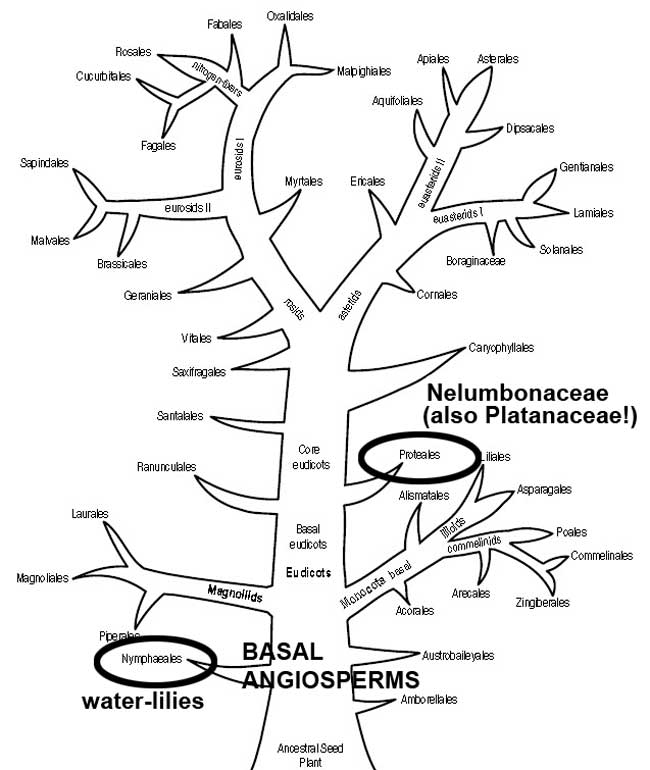
BUY THIS BOOK!
During the past few decades there's been a revolution, still ongoing, in plant classification fostered both by a greater acceptance of cladistic systems that are very strict about basing classification on phylogeny, and the wealth of data from DNA sequences. One very good guide to the new view of flowering plant systemetics is a great book called "A Tour of the Flowering Plants" by Priscilla Spears, published in 2006 by the Missouri Botanical Garden Press.
BUY THIS BOOK!
The book is based on the classification system of the Angiosperm Phylogeny Group. It includes a simplified tree that Spears calls a "map to help you find your way around the thowering plants." The "map," and accompanying text, explains that there is a small group comprising only about 3% of the flowering plants that diverged early from the flowering plant lineage, appropriately termed "basal angiosperms." Close to the ancestral seed plants, this group includes the water lilies (Nymphaeales), but not the lotuses. The Nelumbonaceae is in the Proteales, located farther up the tree in the "Basal Eudicots."

BUY THIS BOOK!
Spears' treatment of the Nelumbonaceae includes the pleasant surprise that, in our flora, the closest relative of lotus is Platanus, our American sycamore! Look
how well it's explained that the similarities between the two families
of aquatic herbs is apparently due to convergent evolution. DNA data
led to this findking, which has since been corroborated by a closer
look at anatomical and developmental traits shared by Nelumbo and Platanus.
"Just So" Floral Extrafloral Nectaries on Sullivant's Milkweed?
July 19, 2010
Killdeer Plains Wildlife Area, Marion County, Ohio
An interesting feature exhibited by a few plants is the "extrafloral nectary," a glandular structure, usually at the base of a leaf, that produces an energy-rich sugary substance fed upon by some insect that is not involved in pollination. Typically the plant-insect relationship is a mutualism, wherein the insects, most often ants, contribute to the plant's well-being by by acting as bodyguards, fending off potential herbivores. Ants feeding on narrow-leaved vetch extrafloral nectaries last year can be seen here.
However, could there be nectaries that are "extrafloral" in the sense that they serve to attract non-pollinating insects, but that are "floral" in that they are indeed located on the flowers? It seems that maybe there's something like that going on with Sullivant's milkweed.
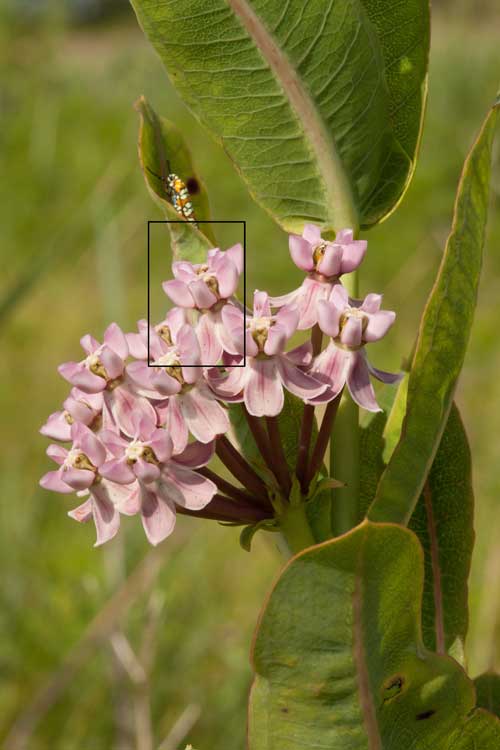
Sullivant's Milkweed. June 19, 2010. Killdeer Plains Wildlife Area.
See below for closer look at framed region.
Examining
closely these
flowers under a dissecting scope, Team Millkweed discovered a
peculiarity that doesn't seem yet to have been reported in the fairly
exhaustive scientific literature on milkweed flower structure and
associated reproductive ecology. This is a set of 10 small,
upwardly-projecting swollen flaps of tissue located where the hood
rises off the central column. Each flap seems to loosely cover a small
opening to the nectar-containing portion of the flower, i.e., the
interior base of the hoods and the adjacent stigmatic chambers. Two of
these flaps are depicted in the photo below, an
enlargement of the boxed area of the photo above. Are they nectaries?
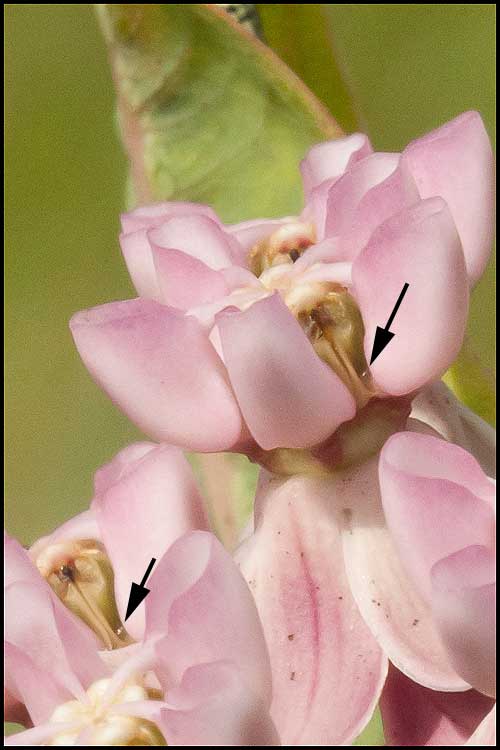
Possible floral extrafloral nectaries on Sullivant's milkweed.

Possible floral extrafloral nectaries on Sullivant's milkweed.
One of the tenets of
evolutionary theory is, of course, that a novel and intricate aspect of
an organism constitutes an adaptation, i.e., a genetically based
feature that increases its ability to survive and reproduce in a
particular environment. However, while the value of a particular trait
may sometimes seem apparent,
strong experimental evidence is often
lacking concerning the specific way (or ways) in which it benefits the
organism. Thoughtful
tentative explanations, intruguing but speculative, are often
criticized. Such untested claims have been called "Just So Stories"
in a derisive homage to Rudyard Kipling's set of childen's stories such
as "How the Camel Got His Hump," etc.
Here's a "Just So" story about milkweeds. Perhaps this little set of openings to the nectar at the base of the flower provides a means by which nectar feeding but non-pollinating insects such as various bugs, ants, flies, and very small moths and bees can do their useless nectar feeding in a manner that interferes less with the beneficial pollinating foragers.
Here's a large milkweed bug, Oncopeltus fasciatus, feeding directly from the hood in a manner that might discourage a honeybee or a butterfly (potential pollinators) from occupying that same space.
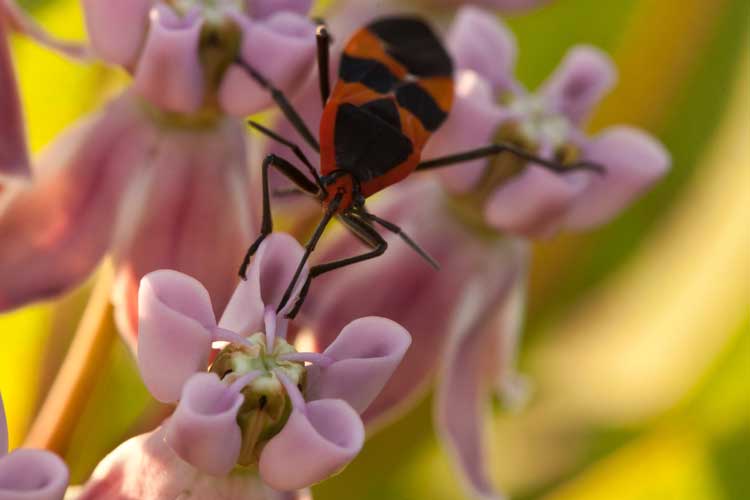
Large milkweed bug drinking nectar directly from the hood.
July 19, 2010. Killdeer Plains Wildlife Area. Marion County, Ohio.
Here's a "Just So" story about milkweeds. Perhaps this little set of openings to the nectar at the base of the flower provides a means by which nectar feeding but non-pollinating insects such as various bugs, ants, flies, and very small moths and bees can do their useless nectar feeding in a manner that interferes less with the beneficial pollinating foragers.
Here's a large milkweed bug, Oncopeltus fasciatus, feeding directly from the hood in a manner that might discourage a honeybee or a butterfly (potential pollinators) from occupying that same space.

Large milkweed bug drinking nectar directly from the hood.
July 19, 2010. Killdeer Plains Wildlife Area. Marion County, Ohio.
...and
here's an instance where the bug seems to have its beak on the
auxilliary structure that, if it is serving as a nectary, is doing so
in a manner that facilitates feeding from a lower position, freeing the
hood area for foraging by insects more likely to transfer pollinia.
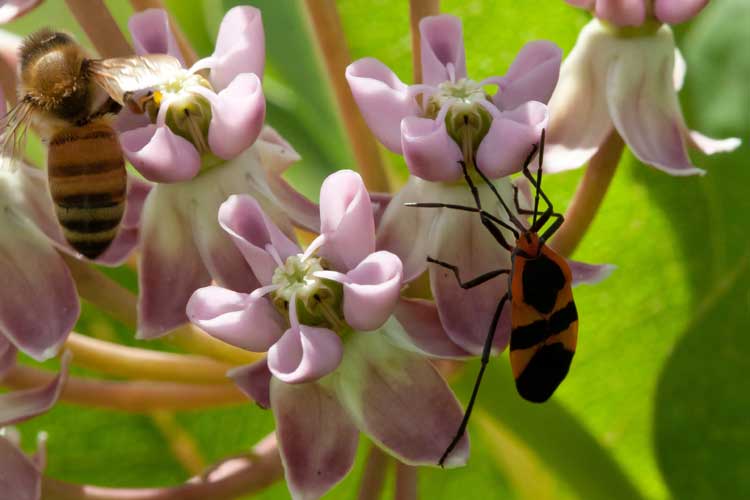
Large milkweed bug drinking nectar from below.
July 19, 2010. Killdeer Plains Wildlife Area. Marion County, Ohio.

Large milkweed bug drinking nectar from below.
July 19, 2010. Killdeer Plains Wildlife Area. Marion County, Ohio.
Here's a similar set of
photos for an unidentified fly. First, plunk down in the hood.
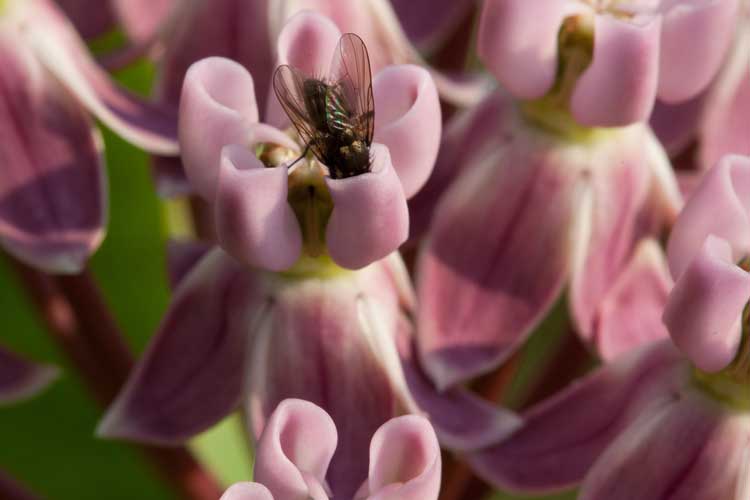
Fly drinking nectar directly from the hood.
July 19, 2010. Killdeer Plains Wildlife Area. Marion County, Ohio.

Fly drinking nectar directly from the hood.
July 19, 2010. Killdeer Plains Wildlife Area. Marion County, Ohio.
...and
here it is again, possibly exploiting the putative "floral extrafloral
nectary," well out of the way of helpful honeybees.
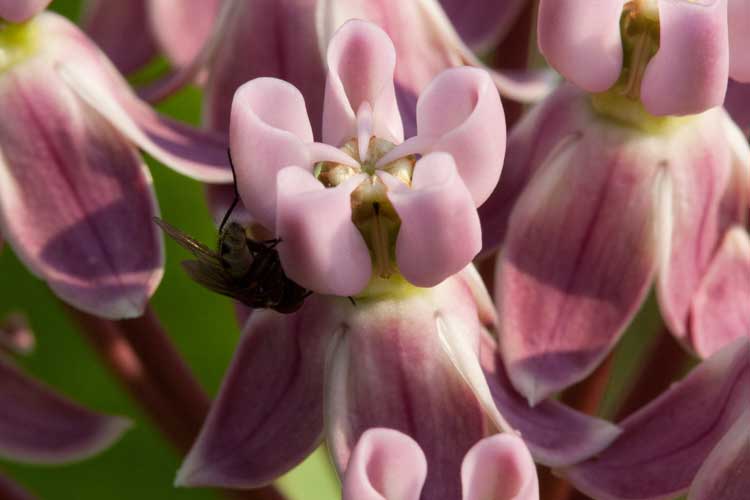
Fly drinking nectar directly from below.
July 19, 2010. Killdeer Plains Wildlife Area. Marion County, Ohio.

Fly drinking nectar directly from below.
July 19, 2010. Killdeer Plains Wildlife Area. Marion County, Ohio.
Milkweeds are People, Too!
July 19, 2010.
Killdeer Plains Wildlife Area, Marion County, Ohio
One of the most enjoyable
arguments you can have with someone, and it really doesn't matter which
side you take, is whether or not individual non-human animals are
distinctive like people are. The fact that
humans are instantly recognizable seems important because,
as social animals, we engage in reciprocal exchanges, altruism and
trade. Hence we need to keep track of who is trustworthy, owes us a
favor, or is a cheater. But what about all those animals that seem to
look exactly alike, like toads and birds? The fact that I
can't tell one from another might not mean much, because, not
being a toad or a bird, I don't have an eye for what makes each one of
them unique.
But there shouldn't be any debate about individual Sullivant's milkweeds. I have no idea why, but they're wildly variable and distinctive! Team Milkweed learned this during field work examining the potential for variation in gene flow among plants that consisted either of large multi-stemmed clones, or small few-stemmed ones. Based on appearance, we had to try to guess whether stems ("ramets") standing alongside one another belonged either to the same or to different genetic individuals ("genets").
To get a feeling for phenotypic variation in Sullivant's milkweed, I merrily pranced across the meadow, and snapped pictures of bundled-together pairs of adjacent stems that resembled each other in terms of flower colors, the shapes of their flowers, and the timing of flowering.
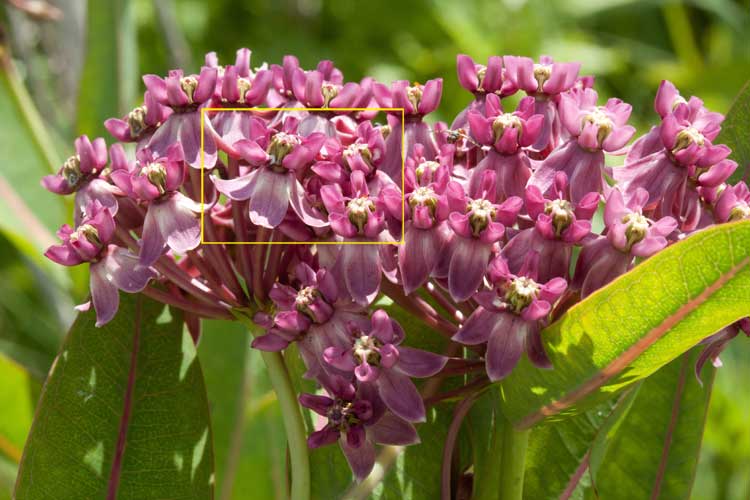
Two milkweed stems bundled together. July 19, 2010. Killdeer Plains.
Yellow-boxed area encloses flowers from both stems, featured in Gallery 2 below.
Here's Image Gallery 1, demonstrating among-plant variation in Sullivant's milkweed.
But there shouldn't be any debate about individual Sullivant's milkweeds. I have no idea why, but they're wildly variable and distinctive! Team Milkweed learned this during field work examining the potential for variation in gene flow among plants that consisted either of large multi-stemmed clones, or small few-stemmed ones. Based on appearance, we had to try to guess whether stems ("ramets") standing alongside one another belonged either to the same or to different genetic individuals ("genets").
To get a feeling for phenotypic variation in Sullivant's milkweed, I merrily pranced across the meadow, and snapped pictures of bundled-together pairs of adjacent stems that resembled each other in terms of flower colors, the shapes of their flowers, and the timing of flowering.

Two milkweed stems bundled together. July 19, 2010. Killdeer Plains.
Yellow-boxed area encloses flowers from both stems, featured in Gallery 2 below.
Here's Image Gallery 1, demonstrating among-plant variation in Sullivant's milkweed.
GALLERY
1: VARIATION
BETWEEN CLONES
(YELLOW BOXED AREAS ARE FEATURED IN SECOND GALLERY BELOW )
(YELLOW BOXED AREAS ARE FEATURED IN SECOND GALLERY BELOW )
Image Gallery 2 zooms in on the flowers, highlighting within-clone similarity. Like the gallery above, it's also a good example of that annoying optical illusion where you see little gray squares that aren't really there.
GALLERY
2: SIMILARITY
WITHIN CLONES
(YELLOW-BOXED AREAS FROM FIRST GALLERY)
(YELLOW-BOXED AREAS FROM FIRST GALLERY)
Many Milkweed Metazoans
Early-Mid July, 2010
Killdeer Plains Wildlife Area, Marion County, Ohio
It's plainly evident that the
European honeybee, Apis mellifera,
is
the principal, indeed essentially the only, pollinator of Sullivant's
milkweed here at Killdeer Plains. The bees are abundant, they forage
extensively, and can regularly be seen carrying milkweed pollinaria.
Here's yet another snapshot of a milkweed umbel featuring
a foraging bee.
MOUSEOVER the image to see more closely the pollinaria attached to her
legs.
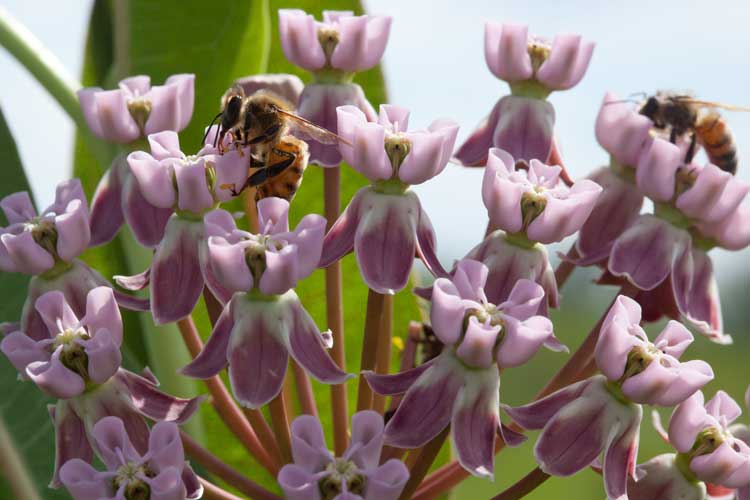
Honeybees forage avidly on Sullivant's killweed at Milkdeer. July 19, 2010.
...and they doubtlessly transfer pollinia from plant to plant as they travel.
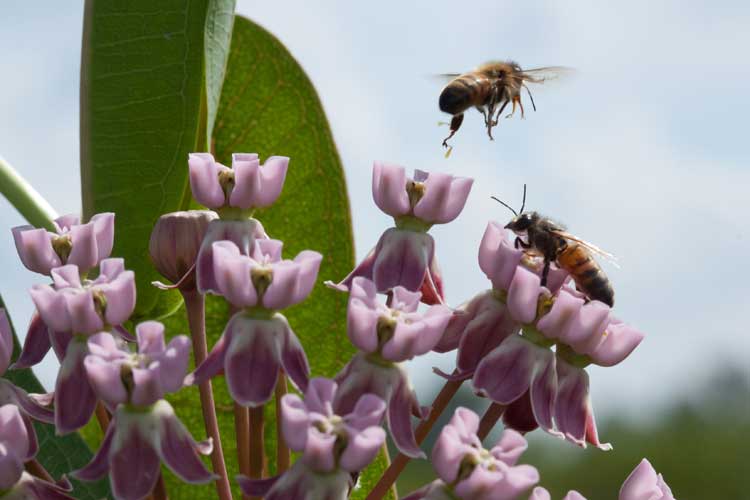
Honeybee carries pollinia at Killdeer Plains. July 19, 2010.
Honeybee beset with pollinaria somehow manages not to insert any, or withdraw more.
MOUSEOVER the IMAGE for
ZOOM-CROP of BEE

Honeybees forage avidly on Sullivant's killweed at Milkdeer. July 19, 2010.
...and they doubtlessly transfer pollinia from plant to plant as they travel.
MOUSEOVER the IMAGE to see
ZOOM-CROP of BEE

Honeybee carries pollinia at Killdeer Plains. July 19, 2010.
Here's yet another video of a
honeybee foraging on Sullivant's milkweed. I've got dozens of these and
have watched them all, closely, in a vain (fruitless vain, not
egotistical vain, but maybe some of that too because they are quite
nice videos)
attempt to catch one in the act of pollinarium withdrawl or pollinium
insertion. So far, no luck. Maybe milkweeds like their privacy.
Honeybee beset with pollinaria somehow manages not to insert any, or withdraw more.
Descriptions of milkweed
pollination sometimes include a scenario wherein a foraging insect will
get its foot caught in the stigmatic groove and, while trying to
extricate itself, withdraw a pollinarium and then fly off with it.
That may be happen, but it seems the pollinaria can be withdrawn
cleanly,
without all that drama. Nonetheless, bees often do get caught, and stay
that way. Here's a honeybee with several feet
snared.
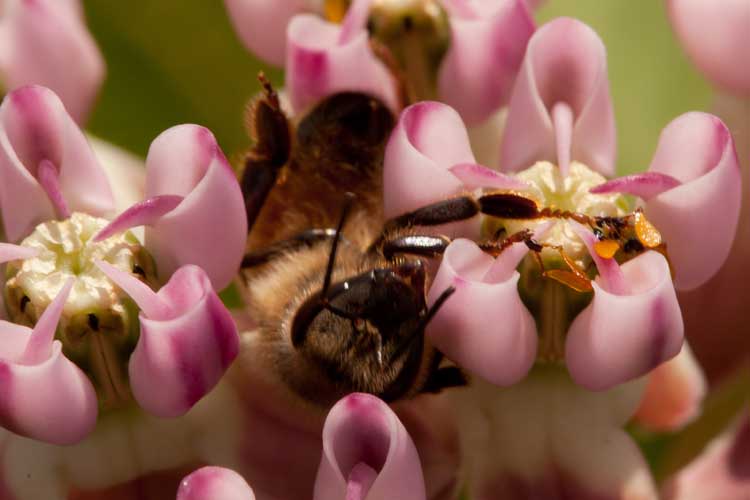
Honeybee fast on milkweed. July 10, 2010.

Honeybee fast on milkweed. July 10, 2010.
Here's
the video they
show in at scary special assembly every year at Honeybee High, to
frighten those crazy kids, and keep them from playing on the milkweeds.
But they
never listen.
Honeybee snagged by milkweed flower. Sad, so sad.
Honeybee snagged by milkweed flower. Sad, so sad.
But its not all honeybees all the
time. Other insects visit the flowers, although they don't seem to
carry many (any) pollinia. A terrific milkweed associate is the large
milkweed bug, Oncopeltus fasciatus.
This is a type of
"seed bug" that does, indeed, feed largely on milkweed seeds. They are
often accessed by piercing the wall of a milkweed fruit. But they also
sip nectar, passing time until fruits arrive.
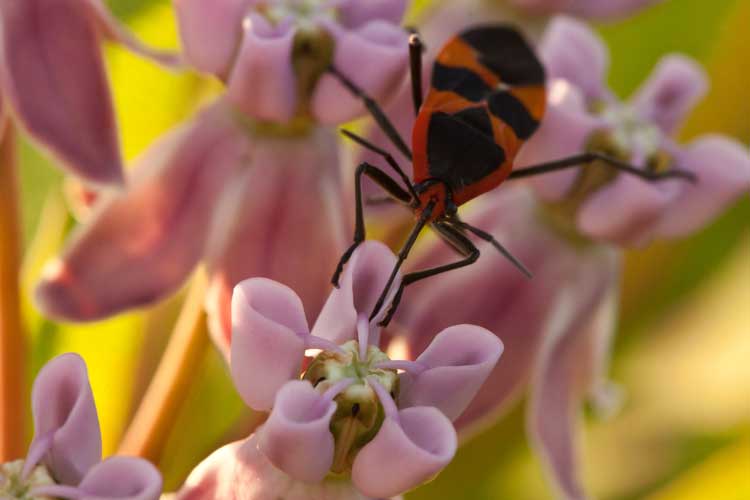
Large milkweed bug sips nectar. Killdeer Plains. July 19, 2010.
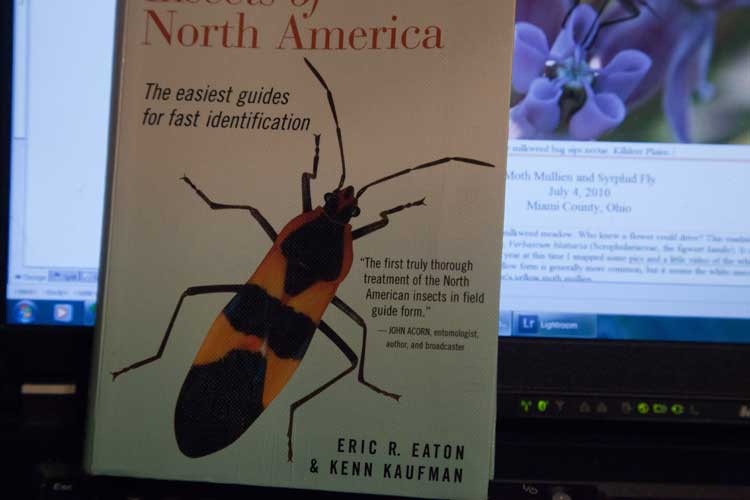
Large milkweed bug is a star! (This is very "meta.")

Large milkweed bug sips nectar. Killdeer Plains. July 19, 2010.
The large milkweed bug is an
especially charismatic insect, as evidenced by the fact that
it's all by itself on the cover of Eaton and Kaufman's excellent
"Insects of North America."

Large milkweed bug is a star! (This is very "meta.")
The milkweed bug is a good example
of a true "bug" in the entomologist's sense, i.e., a member of the
order Hemiptera, a large and diverse group with sucking beak-like
mouthparts tucked beneath the body when not in use, and an
incomplete metamorphosis wherein immatures resemble miniature adults,
but with incompletely developed wings. In their suborder, Heteroptera
(the "original" true bugs), the wings are oriented to give the
insect a very flat-backed appearance, and each forewing is thickened in
its forward half, giving it a somewhat two-toned
appearance.
Here's an action-packed video of a large milkweed bug sipping nectar.
Buggy buggy slurpy slurpy.
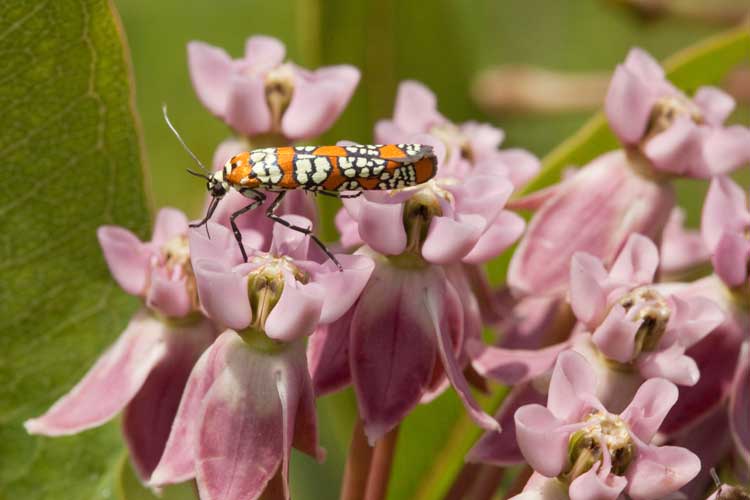 Ailanthus webworm moth
sips milkweed nectar. July 19, 2010.
Ailanthus webworm moth
sips milkweed nectar. July 19, 2010.
Here's an action-packed video of a large milkweed bug sipping nectar.
Buggy buggy slurpy slurpy.
Another brightly colored
asclepiavore is a type of longhorn beetle, the red milkweed beetle, Tetraopes tetropthalamus. Eaton and
Kaufman tell us that are 13 species of Tetraopes in North America, and
that "most of the species studied so far specialize on one or a few
species of milkweeds, the larvae mining in the roots, the adults
feeding on the upper foliage and blooms." They do so in a manner the
authors rightly characterize as "boldly in the open by day, their
bright colors advertising their toxic nature." This species, they note,
is the most numerous milkweed beetle in our region, and it feeds
chiefly on common milkweed, Asclepias
syriaca, but has been noted on at least two other Asclepias species. It is
interesting to note that these two extremely bold beetles have
evidently read the book and accordingly selected one of the few A. syrica plants (note the velvet
underleaf) in a sea of Sullivant's.
Another Tetraopes peculiarity that Eaton and Kaufman mention is that "each eye is divided by the antennal socket, hence they are often called 'four-eyed beetles'." It's true.
One of the few easily identified small moths sometimes called "microlepidoptera" is the Ailanthus webworm moth, Atteva punctella. Their larvae occur in communal webs on tree-of-heaven (Ailanthus) trees.
Another Tetraopes peculiarity that Eaton and Kaufman mention is that "each eye is divided by the antennal socket, hence they are often called 'four-eyed beetles'." It's true.
MOUSEOVER the IMAGE for a
ZOOM-CROP showing the nifty FOUR-EYE-NESS
One of the few easily identified small moths sometimes called "microlepidoptera" is the Ailanthus webworm moth, Atteva punctella. Their larvae occur in communal webs on tree-of-heaven (Ailanthus) trees.
 Ailanthus webworm moth
sips milkweed nectar. July 19, 2010.
Ailanthus webworm moth
sips milkweed nectar. July 19, 2010.Here's another apparently
non-pollinating insect, a fly, dipping deeply onto a Sullivant's
milkweed hood.
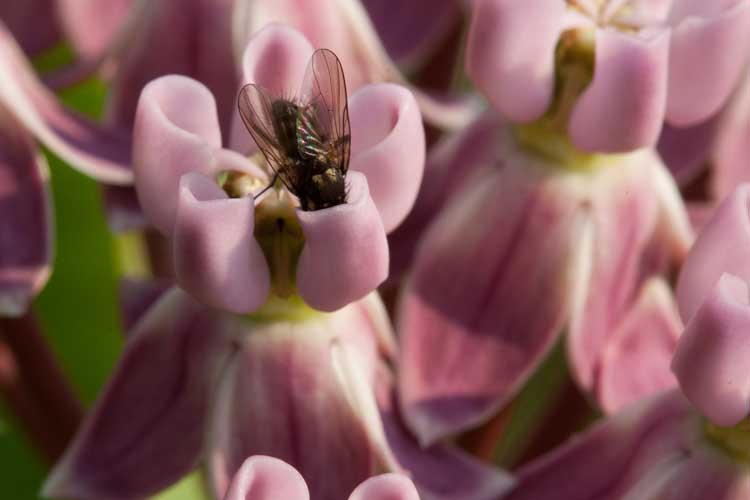
Fly feeding on mikweed nectar at Killdeer Plains. July 14, 2010.

Fly feeding on mikweed nectar at Killdeer Plains. July 14, 2010.
...and here's a video of the fly
feeding.
Fly feeds on milkweed nectar at
Killdeer.
It was an rare treat to see a
lightning bug wandering about on a milkweed umbel. It looks like Photinus pyralus, a common species.
Photinus
firefly on milkweed umbel at Killdeer.
Moth Mullien and Syrphid Fly
July 4, 2010
Miami County, Ohio
I saw a pretty weed driving
to the milkweed meadow. Who knew a flower could drive? This roadside
plant, a native of Eurasia, is moth mullen, Verbascum blattaria
(Scrophulariaceae, the figwort family). It comes in two colors: yellow
and white. Last year at this time I snapped some pics and a
little video of the white form.
According to some sources, the yellow form is generally more common,
but it seems the white ones are more frequent in central Ohio. Here's
yellow moth mullien.
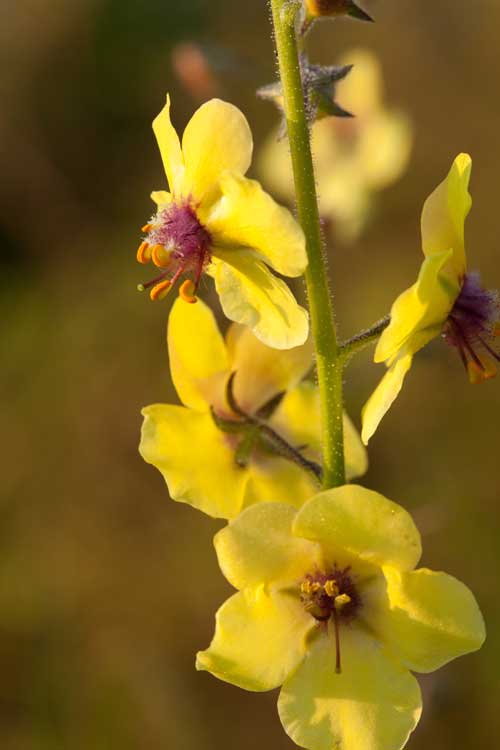
Yellow moth mullien. July 4, 2010. Miami County, Ohio.

Yellow moth mullien. July 4, 2010. Miami County, Ohio.
Moth mullien has
exceptionally long-lived seeds. This was
decisively shown through a wonderful long-running plant ecology
experiment in Michigan, where, in 1879, William
J.
Beals buried 20 vials of soil containing
seeds of 21 different weeds. He developed a
protocol
for
their excavation and viability-testing. The most recent
withdrawls
--there are 5 bottles remaining and the next will be dug up in
2020 --have consistently yielded only moth mullien, plus, in some
instances,
traces of a few other species.
It's called "moth" mullien because its filaments (the anther-supporting stalk portion of the stamens) are plumose, like a moth's antennae. The specific epithet "blattaria" is a reference to roaches, which at one time were thought to be repelled by the plant.
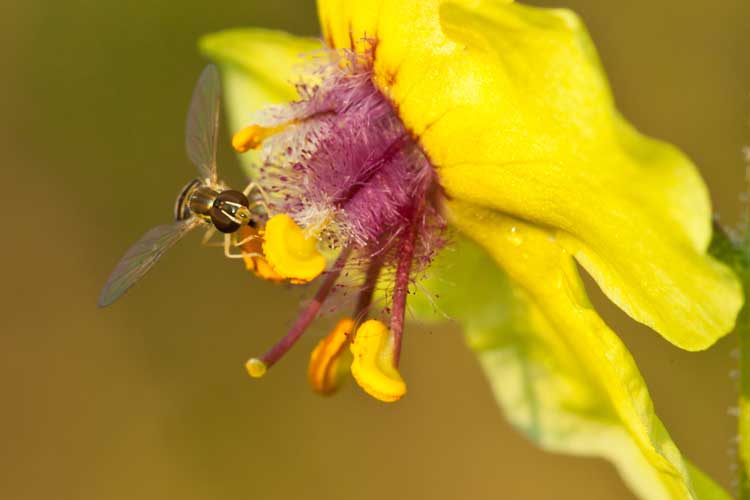
Moth mullien with syrphid fly. July 4, 2010. Miami County, Ohio.
It's called "moth" mullien because its filaments (the anther-supporting stalk portion of the stamens) are plumose, like a moth's antennae. The specific epithet "blattaria" is a reference to roaches, which at one time were thought to be repelled by the plant.

Moth mullien with syrphid fly. July 4, 2010. Miami County, Ohio.
Midnight and Morning Milkweed Marathon
Late June and early July, 2010
Killdeer Plains Wildlife Area, Marion County, Ohio.
Team
Milkweed is hard at
work, discovering what pollinates Sullivant's milkweed (answer:
honeybees),
when the pollination occurs (answer: daytime), and whether
nectar-foraging bees on small clones and large clones differ in whether
they are carrying
pollinia from the same, or different
plants (to be determined).
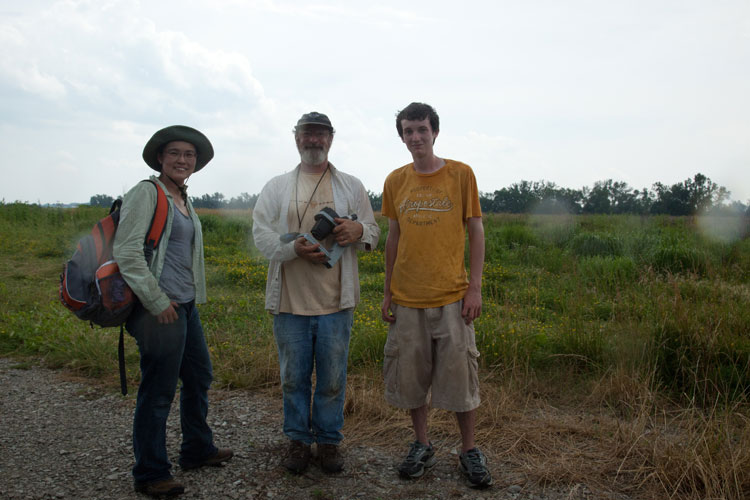
Team Millweed at Killdeer Plains. June 27, 2010.

Team Millweed at Killdeer Plains. June 27, 2010.
Since Milkweed Midsummer is a
longstanding tradition, a description of Sullivant's
milkweed can be found here, and
more detailed information about its pollnation is here.
This summer, the focus is more on the broader pollination ecology of the species rather than just its breeding system and potential for hybridization, so we are noticing more insect species exploiting these beautiful plants. This, for example, is not what it looks like, unless it looks like a fly that looks like a bee. It's a type of flower-fly (Order Diptera; Family Sirphidae) that is a bumblebee-mimic, most likely Mallota bautias.
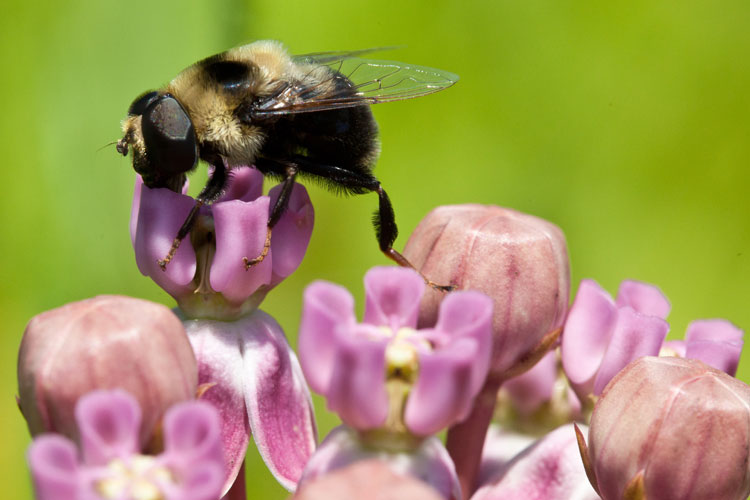
Mallota flower fly forages on milkweed at Killdeer. June 27, 2010.
This summer, the focus is more on the broader pollination ecology of the species rather than just its breeding system and potential for hybridization, so we are noticing more insect species exploiting these beautiful plants. This, for example, is not what it looks like, unless it looks like a fly that looks like a bee. It's a type of flower-fly (Order Diptera; Family Sirphidae) that is a bumblebee-mimic, most likely Mallota bautias.

Mallota flower fly forages on milkweed at Killdeer. June 27, 2010.
Milkweed flowers don't ever
close, so do night-time nectar feeders seek
nectar from them? Indeed, there have been studies showing a small but
substantial amount of nocturnal pollination of
the closely related common milkweed, Asclepias
syriaca.
Our day/night study involves placing mesh bags over the flower clusters
that prevent insect access to them during either the daytime or the
nightime. Here's a night-flying moth that seemed more interested in the
bagged flowers than all the others nearby. It may be a type of owlet
moth, i.e., a member of the lepidopteran Family Nolidae (formerly
included in Noctuidae).
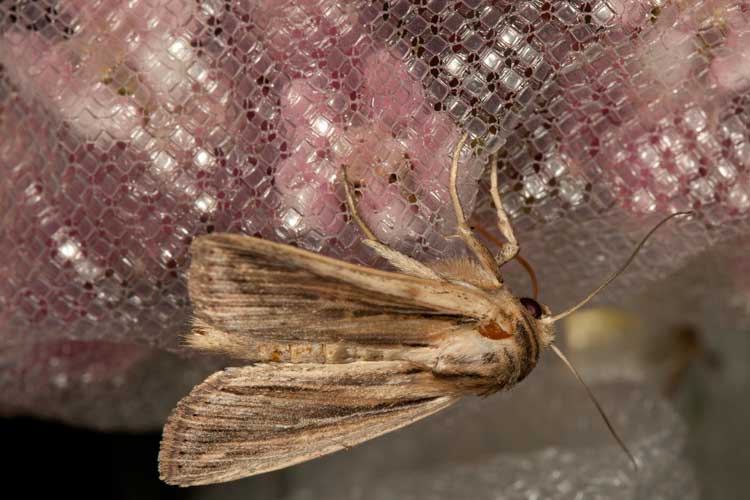
Nolid moth on nylon pollinator exclusion bag. July 1, 2010.

Nolid moth on nylon pollinator exclusion bag. July 1, 2010.
While generally the blossoms
are ignored at night, a few visitors show up. Here's another nolid moth
and, if you look closely, there are at least two of what I guess are
male mosquitoes, because they have plumose antennae and are feeding on
nectar.
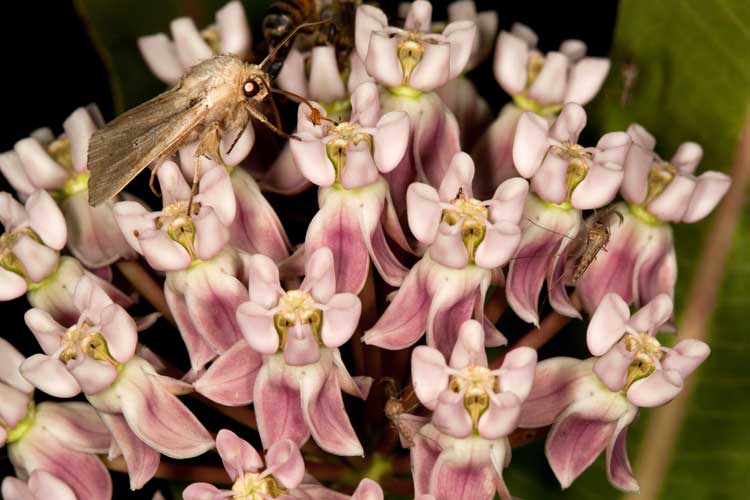
MOUSEOVER IMAGE for ZOOM-CROP of
MALE MOSQUITO

Nolid moth and male
mosquitoes sup on milkweed nectar. July
1, 2010.
Note also a snagged honeybee in the background at the upper edge of the photo.
Note also a snagged honeybee in the background at the upper edge of the photo.
While prowling around at
night it was nice to see a monarch chrysalis on yellow fox sedge (Carex annectans). These "emerald
houses with golden nails" are quite common this summer.
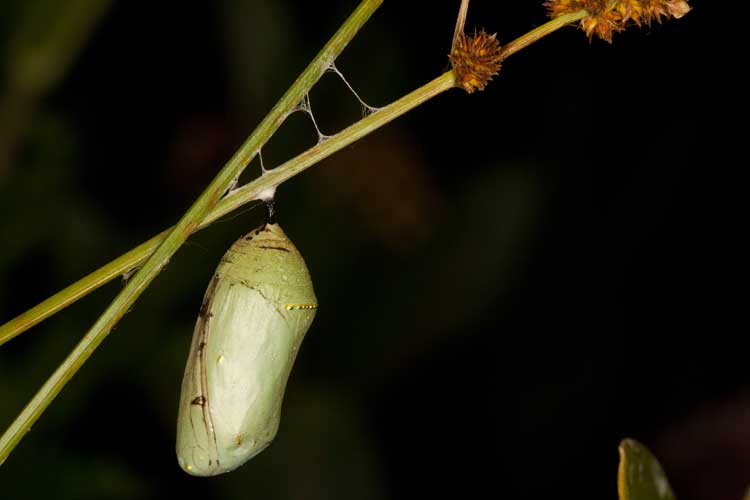
Monarch butterfly chrysalis. July 1, 2010.
Here's the same sedge in the daylight.
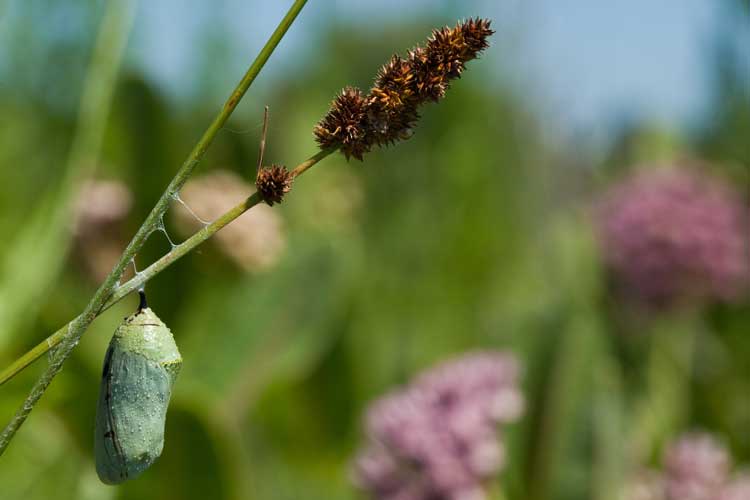
Yellow fox sedge with monarch chrysalis. July 1, 2010.
It is intriguing and informative to observe a variety of insects, day and night, on Sullivant's milkweed blossoms. Nonetheless, many hours of observation indicate that just one insect, a non-native species, the honeybee, is practically its only pollinator at Killdeer Plains. Here's one foraging; note the little yellowish pollinaria attached to her feet.
Honeybee forages on Milkweed at Killdeer. July 10, 2010.
There are a few other milkweed species in the area. One of them, whorled milkweed, Asclepias verticillata, has such small flowers and a small stature, that it is easy to miss.
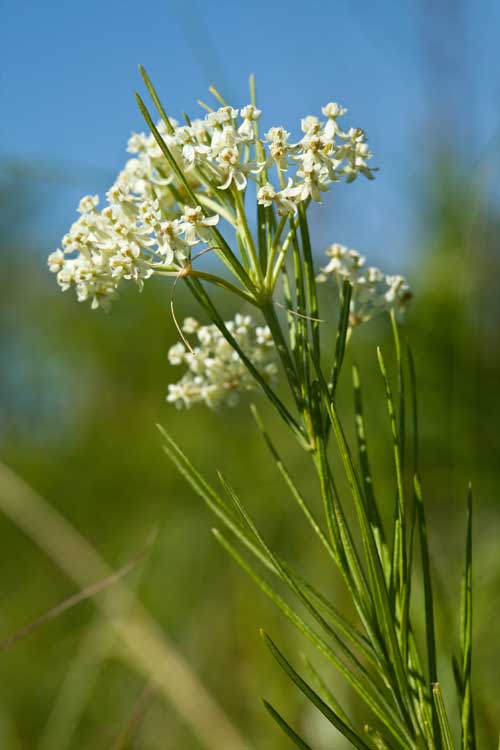
Whorled milkweed at Killdeer. July 2, 2010.
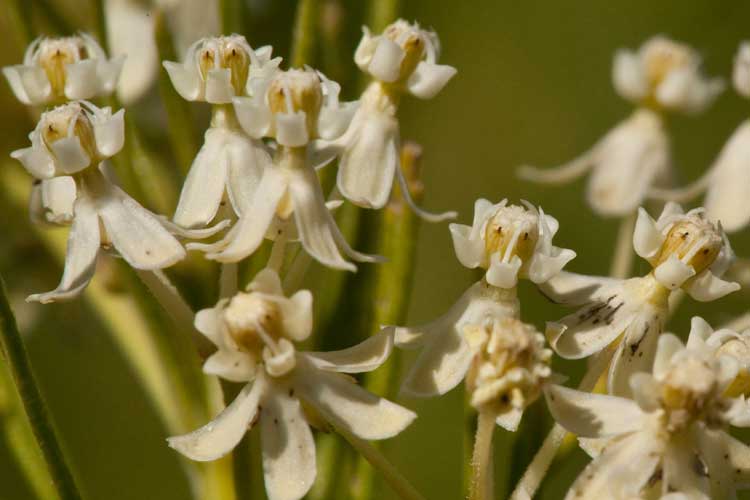
Whorled milkweed at Killdeer. July 2, 2010.



Monarch butterfly chrysalis. July 1, 2010.
Here's the same sedge in the daylight.

Yellow fox sedge with monarch chrysalis. July 1, 2010.
It is intriguing and informative to observe a variety of insects, day and night, on Sullivant's milkweed blossoms. Nonetheless, many hours of observation indicate that just one insect, a non-native species, the honeybee, is practically its only pollinator at Killdeer Plains. Here's one foraging; note the little yellowish pollinaria attached to her feet.
There are a few other milkweed species in the area. One of them, whorled milkweed, Asclepias verticillata, has such small flowers and a small stature, that it is easy to miss.

Whorled milkweed at Killdeer. July 2, 2010.
Whorled milkweed, while
scarce at Killdeer, is exceedingly abundant in some parts of
northwestern Ohio, where it is a weed, for example along interstate
highway I-75 in Wood County. The blossoms are tiny, but with the same
flower structure as its larger congenors.

Whorled milkweed at Killdeer. July 2, 2010.


